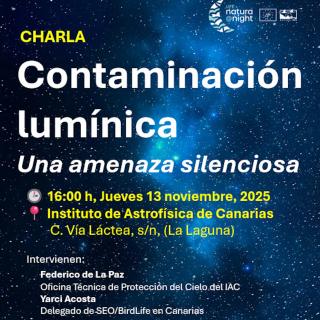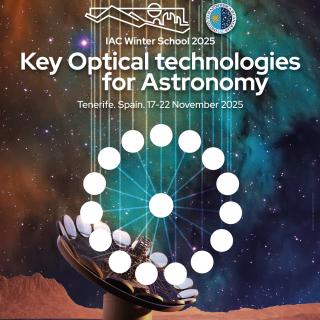It may interest you
-
 Científicos del IAC publican en Nature Astronomy una guía práctica para mejorar propuestas y solicitudesAdvertised on
Científicos del IAC publican en Nature Astronomy una guía práctica para mejorar propuestas y solicitudesAdvertised on -
 Especialistas abordarán el impacto de la iluminación artificial excesiva y sus efectos sobre la astronomía, la salud humana y la biodiversidad El Instituto de Astrofísica de Canarias (IAC) y SEO/BirdLife Canarias celebran la conferencia " Contaminación Lumínica: Una Amenaza Silenciosa", una jornada clave para la protección del medio ambiente y el patrimonio científico del archipiélago. La ponencia estará a cargo de Federico de la Paz, técnico del IAC, y Yarci Acosta de Seo/Birdlife, quien desgranará los graves riesgos que el uso ineficiente y descontrolado de la luz artificial supone para laAdvertised on
Especialistas abordarán el impacto de la iluminación artificial excesiva y sus efectos sobre la astronomía, la salud humana y la biodiversidad El Instituto de Astrofísica de Canarias (IAC) y SEO/BirdLife Canarias celebran la conferencia " Contaminación Lumínica: Una Amenaza Silenciosa", una jornada clave para la protección del medio ambiente y el patrimonio científico del archipiélago. La ponencia estará a cargo de Federico de la Paz, técnico del IAC, y Yarci Acosta de Seo/Birdlife, quien desgranará los graves riesgos que el uso ineficiente y descontrolado de la luz artificial supone para laAdvertised on -
 The Canary Islands Institute of Astrophysics (IAC) is organizing the XXXVI Canary Islands Winter School of Astrophysics , which will be held in San Cristóbal de La Laguna (Tenerife) from November 17 to 22, 2025. Under the title "Key Optical technologies for Astronomy", the school will focus on cutting-edge optical and algorithmic technologies that will define the future of Astrophysics. This edition, led by Professors Jeff Kuhn (University of Hawaii and IAC) and Rafael Rebolo (IAC), will involve approximately 35 advanced Master's students, doctoral candidates, and early-career postdoctoralAdvertised on
The Canary Islands Institute of Astrophysics (IAC) is organizing the XXXVI Canary Islands Winter School of Astrophysics , which will be held in San Cristóbal de La Laguna (Tenerife) from November 17 to 22, 2025. Under the title "Key Optical technologies for Astronomy", the school will focus on cutting-edge optical and algorithmic technologies that will define the future of Astrophysics. This edition, led by Professors Jeff Kuhn (University of Hawaii and IAC) and Rafael Rebolo (IAC), will involve approximately 35 advanced Master's students, doctoral candidates, and early-career postdoctoralAdvertised on
